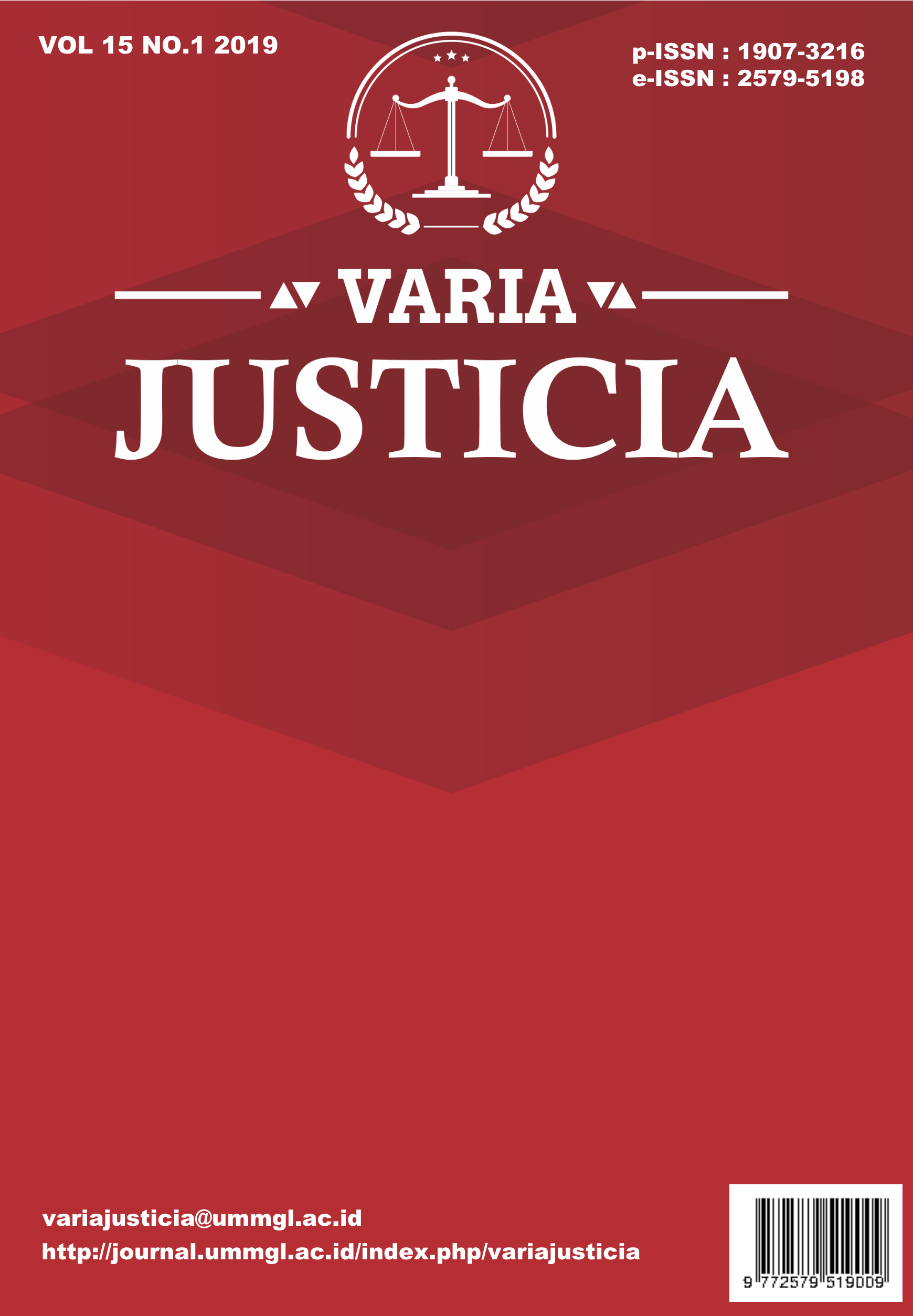Main Article Content
Abstract
This study aims to analyze the implementation and identify the obstacles to control of street vendors (PKL) by the Civil Service Police Unit (Satpol PP) in Temanggung Regency. This research was conducted with a qualitative approach through in-depth interviews with Satpol PP Officers. Secondary data was obtained from legal materials consisting of Regulation of the Minister of Home Affairs Number 54 of 2011 concerning Operational Standards for Civil Service Police Procedure and Regional Regulation of Temanggung District Number 12 of 2011 concerning Cleanliness, Beauty, Order, and Environmental Health. The data analysis technique used in this research is descriptive qualitative. The results showed that controlling the street vendors conducted by Satpol PP was carried out through several stages, namely 1) coaching and socialization; 2) issuing warning letters, and; 3) demolition of merchant stalls. This control effort has not been able to reduce the number of street vendors who break the rules. Constraints faced in the efforts to control street vendors, among others: 1) the rules which are used as the basis for control are still general in nature; 2) there is no specific location for the existence of street vendors; 3) sanctions are regulated only in the form of criminal sanctions; 4) human resources/personnel of Satpol PP are still lacking; 5) lack of coordination across Regional Apparatuses, and; 6) public awareness (PKL) is still low. Thus, Temanggung District Regulation Number 12 of 2011 concerning Cleanliness, Beauty, Order, and Environmental Health has not been effective in generating PKL compliance with regulations.
Article Details
References
- Koconegoro, P., & Pramono, N. (2010). Implementasi Peraturan Daerah Nomor 26 Tahun 2002 tentang Penataan Pedagang Kaki Lima di Kota Yogyakarta. Universitas Gadjah Mada. Universitas Gadjah MAda. Retrieved from http://etd.repository.ugm.ac.id/index.php?mod=penelitian_detail⊂=PenelitianDetail&act=view&typ=html&buku_id=48832
- Permadi, G. (2007). Pedagang Kaki Lima, Riwayatmu Dulu, Nasibmu Kini. Jakarta: Yudistira.
- Philipus M. Hadjon. (2008). Pengantar Hukum Administrasi Indonesia. Yogyakarta: Gadjah Mada University Press.
- Puspitasari, D. E. (2010). Penataan Pedagang Kaki Lima Kuliner untuk Mewujudkan Fungsi Tata Ruang Kota di Kota Yogyakarta dan Kabupaten Sleman. Mimbar Hukum, 22(3), 588–606. https://doi.org/10.22146/jmh.16244
- Ridwan. (2013). Hukum Administrasi Negara Edisi Revisi. Jakarta: Rajawali Pers.
- Soerjono Soekanto. (1985). Efektivikasi Hukum dan Peranan Sanksi. Bandung: CV Remadja Karya.
- Regulations
- Undang-Undang Nomor 12 Tahun 2011 tentang Pembentukan Peraturan Perundang-Undangan (Law Number 12 of 2011 concerning Formation of Regulations)
- Undang-Undang Nomor 23 Tahun 2014 tentang Pemerintahan Daerah (Law Number 23 of 2014 concerning Regional Government)
- Peraturan Pemerintah Nomor 16 Tahun 2018 tentang Satuan Polisi Pamong Praja (Government Regulation Number 16 Year 2018 concerning Civil Service Police Unit)
- Peraturan Presiden Nomor 125 Tahun 2012 tentang Koordinasi Penataan dan Pemberdayaan Pedagang Kaki Lima (Presidential Regulation Number 125 of 2012 concerning Coordination of Structuring and Empowering Street Vendors)
- Peraturan Daerah Kabupaten Temanggung Nomor 12 Tahun 2011 tentang Kebersihan, Keindahan, Ketertiban, dan Kesehatan Lingkungan (Temanggung Regency Regulation Number 12 of 2011 concerning Cleanliness, Beauty, Order and Environmental Health)
- Peraturan Menteri Dalam Negeri Nomor 54 Tahun 2011 tentang Standar Operasional Prosedur Satuan Polisi Pamong Praja (Minister of Home Affairs Regulation Number 54 of 2011 concerning Standard Operating Procedures for Civil Service Police Unit)
- Peraturan Menteri Dalam Negeri Nomor 41 Tahun 2012 tentang Pedoman Penataan dan Pemberdayaan Pedagang Kaki Lima (Regulation of the Minister of Home Affairs Number 41 of 2012 concerning Guidelines for Structuring and Empowering Street Vendors)
